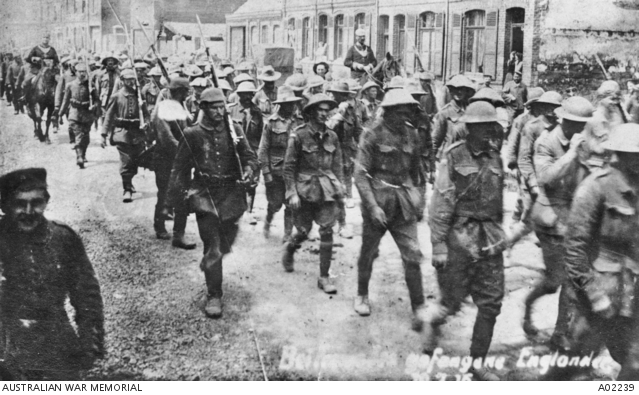Official History
 Informal portrait of C E W Bean working on official files in his Victoria Barracks office during the writing of the Official History. The files on his desk are probably the Operations Files, 1914-18 War, prepared by the Army between 1925 and 1930 and now held by the Australian War Memorial as AWM 26.
Informal portrait of C E W Bean working on official files in his Victoria Barracks office during the writing of the Official History. The files on his desk are probably the Operations Files, 1914-18 War, prepared by the Army between 1925 and 1930 and now held by the Australian War Memorial as AWM 26.
The starting point for any WW1 Australian military history research: C.E.W Bean’s Official History of Australia in the War of 1914–1918:
- Volume 3, The Australian Imperial Force in France, 1916 (12th edition, 1941), chapter 12 and chapter 13
- C. E. W. Bean’s diary on the battle of Fromelles
Books
Fromelles: our darkest day by Patrick Lindsay, 2007, 2016

Accessible, enjoyable read. Excellent introduction and explanation of the battle and all those involved. The second half of the book is devoted to the fascinating story of the discovery and reinternment of missing Australian war dead.
The following appendices were also useful: Appendix VI. Major General von Braun Order No. 5220; Appendix I. The Order of Battle, Fromelles; Appendix II.The Missing Diggers of Fromelles; Appendix III. 5th Division AIF Deaths, Fromelles. Appendix IV. Casualties of World War I Appendix V. Brothers who Died at the Battle of Fromelles; Appendix VI. Major General von Braun Order No. 5220- this last one is of particular importance.
 Australian and British prisoners captured during the Battle of Fleurbaix during 19 July 1916 and 20 July 1916 being escorted through the city streets. This photograph was picked up by the donor in trenches at Villers Bretonneux. AWM A02239
Australian and British prisoners captured during the Battle of Fleurbaix during 19 July 1916 and 20 July 1916 being escorted through the city streets. This photograph was picked up by the donor in trenches at Villers Bretonneux. AWM A02239
The lost legions of Fromelles: the true story of the most dramatic battle in Australia’s history by Peter Barton, 2014

Written by the world’s recognised leading Fromelles historian commissioned by the Australian Government to carry out research into the Pheasant Wood fallen, drawing on translations of German military documents. Unit and intelligence reports of interrogations of prisoners with interesting conclusions. Updated research on grave repatriations and comparisons with reporting by C.E.W Bean. Excellent full-colour map plates from German archives. Paul Daley from the Guardian has a review.
Peter Barton opened a talk at Stanton Library in 2014 with one of the reasons why this battle was significant, bringing up a picture of a photo of two German commanders.
These two men would have known Adolf Hitler, he would have taken messages to them and taken messages from them to headquarters. Fromelles formed a part of the making of the mind of a monster. That was part of his formation, the formation of his mind, of what he had to endure in the First World War, his wounding and his gassing and then the appalling Versailles treaty.
– Richard Jackson, North Sydney Times.
Patrick Lindsay also devotes a chapter to the Lance-Corporal who, unfortunately, wasn’t a casualty. Interestingly enough his first evening – after signing off on France’s defeat in 1940, which in his eyes reversed the humiliation of defeat in 1918 – was spent with a few veterans of his old Bavarian division. Hitler paid a visit to Fromelles, took photos of the pillbox he sheltered in during the Australian attack and dedicated a plaque in his old billet. Pictures of the 20th century’s most notorious mass murderers are online and won’t be published here. The incongruity of pen and brush works, – including one of Fromelles – of this dog-loving vegetarian tea-totaller, with that of a disturbed, driven, megalomaniac is a puzzle psychologists and historians have no doubt sifted over.
 Bunkerunterstand bei Fromelles, Juli 1916. Image: Bundesarchiv Source
Bunkerunterstand bei Fromelles, Juli 1916. Image: Bundesarchiv Source
Fromelles: the final chapters by Tim Lycett and Sandra Playle, 2016
From the cover:

The Battle of Fromelles is Australia’s worst 24 hours according to the Australian War Memorial. As a result of the attack on 19-20 July 1916, the Australian casualties numbered 5533 men, including 1917 killed. For ninety years, the fate of the Diggers who broke through enemy lines was unknown. Then in 2008, the remains of 250 Australian soldiers were discovered in an unmarked mass grave at Pheasant Wood, and one of the great mysteries of World War I was finally solved.
This is the story of a mission to identify and reclaim those lost Diggers. Former forensic crime scene investigator Tim Lycett details how determined volunteers worked with bureaucracies across the world to link the dead with their families nearly a century after the event. He brings to light the deeply moving personal stories of Australian soldiers who died on the battlefield of Fromelles, and who might otherwise have remained unknown forever.

The Battle of Fromelles: 1916 by Roger Lee, 2010
Excellent breakdown of battle into stages, Brigades and Battalions. Analysis of big picture strategy. Biographies of key players. Excellent sub-pages devoted to types of ordinance and technology — trench weaponry artillery, mortars, rifles, machine guns etc. Clear and relevant maps, helping the reader to understand the narrative of the battle. Colour photos of the Pheasant Wood dig.
The Fromelles story…
- Cobbers remembered: Fromelles 19/06/1916
- Cobbers remembered: Lost Diggers of the 53rd
- Cobbers remembered: Allan Allsop’s ‘terrible night’
- Cobbers remembered: Mosman’s dead